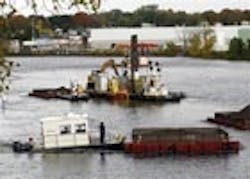Second Phase of Historic Hudson River Cleanup Underway
Environmental Protection Agency (EPA) officials announced that the dredging of sediment contaminated with polychlorinated biphenyls (PCBs) has resumed in the Upper Hudson River, marking the start of the second and final phase of the Hudson River cleanup.
The historic dredging project targets approximately 2.4 million cu yd of PCB-contaminated sediment from a 40-mile section of the Upper Hudson River between Fort Edward and Troy, N.Y. PCBs are potentially cancer-causing in people and build up in the fat of fish and mammals, increasing in concentration as they move up the food chain. The primary risk to humans is the accumulation of PCBs in the body from eating contaminated fish.
General Electric (GE) is conducting the cleanup work with EPA oversight, under an agreement with the agency. This final phase of the cleanup project is expected to take five to seven years to complete.
During the 2011 dredging season, mechanical dredges will collect buckets of PCB-contaminated sediment from a 1.5-mile stretch of river just south of the town of Fort Edward. Four to six dredges will work 24 hours a day, six days a week through the summer and fall to remove approximately 350,000 cu yd of PCB-contaminated sediment from 100 acres of river bottom. Dredging will begin in the western channel of Roger’s Island and move south in the main stem of the river.
Between 1947 and 1977, an estimated 1.3 million lb of PCBs were discharged into the river from two GE plants located in Fort Edward and Hudson Falls.
Source: EPA
